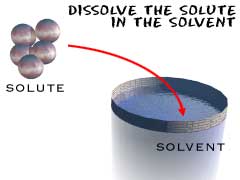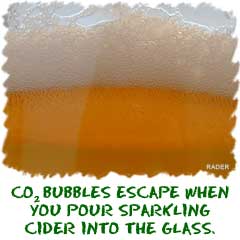
Our goal for this quiz is for all classes to have an average score of
22/25. Together we can achieve great things but we must support and care for one another!! The quiz will be over the water cycle diagram (resources), water cycle key terms (resources), Solutions and solution terms (resources). Go over your terms and try to really apply the definitions to real world situations (think about West Virginia water article). I do not want you to just memorize words but rather search for connections in your world. Below is some information on Solutions. It might be helpful as you prepare for the quiz.
Solutions and Mixtures
 Before we dive into solutions, let's separate solutions from other types of mixtures. Solutions are groups of molecules that are mixed up in a completely even distribution. Hmmm. Not the easiest way to say it. Scientists say that solutions are homogenous systems. Everything in a solution is evenly spread out and mixed together. Other types of mixtures can have a little more of one thing (higher concentration) on one side of the liquid when compared to the other side. Let's compare sugar in water (H2O) to sand in water. Sugar dissolves and is spread throughout the glass of water. The sand sinks to the bottom. The sugar-water could be considered a solution. The sand-water combination is a mixture.
Before we dive into solutions, let's separate solutions from other types of mixtures. Solutions are groups of molecules that are mixed up in a completely even distribution. Hmmm. Not the easiest way to say it. Scientists say that solutions are homogenous systems. Everything in a solution is evenly spread out and mixed together. Other types of mixtures can have a little more of one thing (higher concentration) on one side of the liquid when compared to the other side. Let's compare sugar in water (H2O) to sand in water. Sugar dissolves and is spread throughout the glass of water. The sand sinks to the bottom. The sugar-water could be considered a solution. The sand-water combination is a mixture.
Can anything be in a Solution?
Pretty much. Solutions can be solids dissolved in liquids. When you work with chemistry or even cook in your kitchen, you will usually be dissolving solids into liquids. Solutions could also be gases dissolved in liquids (such as carbonated water). There can also be gases in other gases, and liquids in liquids. If you mix things up and they stay at an even distribution, it is a solution. You probably won't find people making solid-solid solutions. They usually start off as solid/gas/liquid-liquid solutions and then harden at room temperature. Alloys with all types of metals are good examples of a solid solution at room temperature.
 A simple solution is basically two substances that are going to be combined. One of them is called the solute. A solute is the substance to be dissolved (sugar). The other is a solvent. The solvent is the one doing the dissolving (water). As a rule of thumb, there is usually more solvent than solute. Be patient with the next sentence as we put it all together. The amount of solute that can be dissolved by the solvent is defined assolubility. That's a lot of "sol" words.
Science has special names for everything. There are names for the different types of homogenous mixtures. Solutions refer to these mixtures when the particles are very small. You may hear about colloids. Colloids are just solutions with much bigger particles. Colloids are usually foggy or milky when you look at them. In fact, milk is an emulsified colloid. You may also hear about colloids if you study soil. Milk is an organic colloid, while soils can be made up of inorganic colloids, such as clay.
A simple solution is basically two substances that are going to be combined. One of them is called the solute. A solute is the substance to be dissolved (sugar). The other is a solvent. The solvent is the one doing the dissolving (water). As a rule of thumb, there is usually more solvent than solute. Be patient with the next sentence as we put it all together. The amount of solute that can be dissolved by the solvent is defined assolubility. That's a lot of "sol" words.
Science has special names for everything. There are names for the different types of homogenous mixtures. Solutions refer to these mixtures when the particles are very small. You may hear about colloids. Colloids are just solutions with much bigger particles. Colloids are usually foggy or milky when you look at them. In fact, milk is an emulsified colloid. You may also hear about colloids if you study soil. Milk is an organic colloid, while soils can be made up of inorganic colloids, such as clay.

Making Solutions

So, what happens? How do you make that
solution? Mix the two
liquids and stir. It's that simple. Science breaks it into three steps. When you read the steps, remember...
Solute=Sugar
Solvent=Water
System=Glass.
1. The
solute is placed in the
solvent and the concentrated solute slowly breaks into pieces. If you start to stir the liquid, the mixing process happens much faster.
2. The molecules of the solvent begin to move out of the way and they make room for the molecules of the solute. Example: The water has to make room for the sugar molecules to spread out.
3. The solute and solvent interact with each other until the concentration of the two substances is equal throughout the system. The concentration of sugar in the water would be the same from a sample at the top, bottom, or middle of the glass.
Can Anything Change Solutions?
Sure. All sorts of things can change the
concentrations of substances in solution. Scientists use the word
solubility. Solubility is the ability of the solvent (water) to dissolve the solute (sugar). You may have already seen the effect of
temperature in your classes. Usually when you heat up a solvent, it can dissolve more
solid materials (sugar) and less
gas (carbon dioxide). If your friend was mixing sugar and water, she would be able to dissolve a lot more sugar into hot water rather than cold.

Next on the list of factors is
pressure. When you increase the surrounding pressure, you can usually dissolve more gases in the liquid. Think about your soda can. It is able to keep the fizz inside, because the contents of the can are under higher pressure. Think about a bottle of soda. The first time you open the bottle, a lot of bubbles come out. If you open and close it over a few hours, fewer and fewer bubbles will come out of the solution. When you opened the bottle the first time, you lost the high pressure that was keeping the carbon dioxide (CO
2) gas in solution.
Last is the
structure of the substances. Some things dissolve easier in one kind of substance as opposed to another. Sugar dissolves easily in water and oil does not. Water has a low solubility when it comes to oil. Since oil is not soluble in water, it will never truly dissolve. Oil and water is a
mixture, not a solution. The two types of molecules (oil and water) are not evenly distributed in the system.

 But the fun is not over. It is time to find out what Detective Finan knows! Check out the Extra Credit Assignment in the Resources page (Det. Finan and the Disappearing Pencils) to find out how it ends and earn some extra points. The extra credit will be due on Friday, May 2. Have fun and enjoy!
But the fun is not over. It is time to find out what Detective Finan knows! Check out the Extra Credit Assignment in the Resources page (Det. Finan and the Disappearing Pencils) to find out how it ends and earn some extra points. The extra credit will be due on Friday, May 2. Have fun and enjoy!











 So, what happens? How do you make that solution? Mix the two
So, what happens? How do you make that solution? Mix the two  Next on the list of factors is pressure. When you increase the surrounding pressure, you can usually dissolve more gases in the liquid. Think about your soda can. It is able to keep the fizz inside, because the contents of the can are under higher pressure. Think about a bottle of soda. The first time you open the bottle, a lot of bubbles come out. If you open and close it over a few hours, fewer and fewer bubbles will come out of the solution. When you opened the bottle the first time, you lost the high pressure that was keeping the carbon dioxide (CO2) gas in solution.
Next on the list of factors is pressure. When you increase the surrounding pressure, you can usually dissolve more gases in the liquid. Think about your soda can. It is able to keep the fizz inside, because the contents of the can are under higher pressure. Think about a bottle of soda. The first time you open the bottle, a lot of bubbles come out. If you open and close it over a few hours, fewer and fewer bubbles will come out of the solution. When you opened the bottle the first time, you lost the high pressure that was keeping the carbon dioxide (CO2) gas in solution.